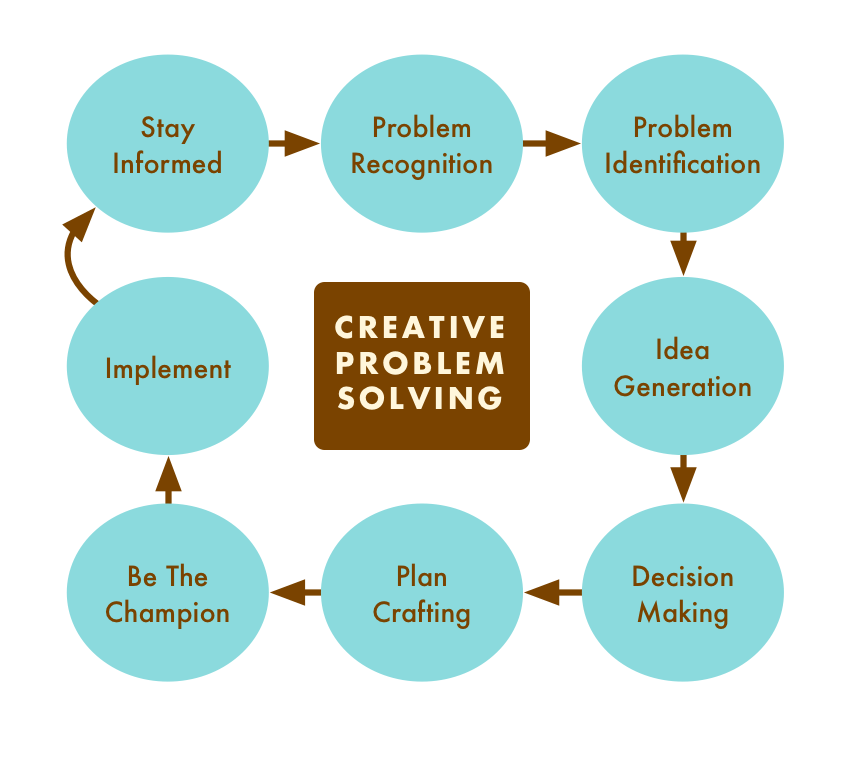Creative Problem Solving (CPS)
Creative problem solving (CPS) is the strategic process to find answers to problems and ways to take advantage of opportunities. Key steps in the process include: identifying a problem, generating alternative solutions, and selecting the best/right answer.
CPS can help you do the things that get you recognized for being innovative.

Here is a summary of the steps:
- Stay Informed – Stay Informed of your own business, your customers, your industry, and your competitors.
- Problem Recognition – The ability to notice that change is about to take place.
- Problem Identification – Once you realize you’ve got a problem, the next step is to determine the cause of an issue. You are identifying the root cause of a problem.
- Brainstorming – Idea generation. Thinking up new ideas.
- Decision Making – Reviewing all the ideas generated and measuring them against the objectives of what you’re trying to solve.
- Plan Crafting – Writing your planned approach. This is the step where it all comes together.
- Be The Champion – Ideas – especially new or those perceived as risky – need champions—ambassadors to share the benefits of testing and implementing.
- Implement – Implementation is where all the pre-work comes together and take action.
- Return to Stay Informed
While a misnomer, I refer to this entire process as brainstorming. I find creative problem solving too jargon-like. Besides, everyone gets the basics of brainstorming.
Let’s jump into the key steps of the process!
Wait, before we go on… I have a quick sidebar about innovation and being innovative…
The Myth of Being Innovative
I hold an opinion that isn’t enjoyed by those trying to sell you ways to be innovative.
You can’t create something that is an innovation. No more than your agency can craft a viral video or a director can create an Oscar-winning movie.
What is innovative is not decided by a company, or an agency, or a movie studio. That audience awards that designation or user who deems something innovative. Or the viewer who decides to share your video. A small voting group selects Oscars.
What we can do, and our goal is to try to do all the right things to make what we do remarkable so when your customers see and try it – they will declare it an innovation!

At first, it seems daunting all the things you have to pay attention to simultaneously. However, as you practice, it becomes easier.
Like driving a car, an innovation process isn’t a simple “hit the gas” and go process. You’re constantly surveying the road ahead, looking for obstacles, making small adjustments, paying attention to changes in the weather and opportunities along the way.
Stay Informed
Stay Informed of your own business, of your customers, of your industry, of your competitors.
Stay Informed is the first step in the “tasks of innovation” and the creative problem solving (cps) cycle.
To “stay informed” or monitor means being constantly aware of your environment. Follow and track your industry, your customers, your competition, your competition’s customers, your own company from the outside and the inside out. Track the trends. See also the topic Monitor.
It will be easier for you to notice subtle changes and anticipate needs by staying on a constant lookout.
Articles: Stay Informed
Idea Sandbox articles tagged with “stay informed.”
Problem Recognition
Problem Recognition is critical. It is the ability to notice that change is about to take place—sort of like noticing it getting cloudy and the wind changing before a storm. The earlier you detect changes, the faster you can adapt to what you’re doing.
As quickly as you notice something is shifting, go to the next stage, Problem Identification.
Problem Identification
Once you realize you’ve got a problem – discovered in the problem recognition stage, the next step is to determine the cause of an issue. Identifying the root cause of a problem. This is the stage where you “Frame” your problem. You will establish your objective based on the problem identified.
If you have found a need, issue, problem, or opportunity – you need to determine the cause of the problem.
Proper identification of true causes will lead to developing the appropriate remedy. You will come up with and implement solutions based on the work in this stage.
Be a troubleshooter. Now that you can anticipate a need, issue or opportunity, you have to determine its true cause. You don’t want an aspirin to ease a headache; you want to prevent what’s causing the headache. This step is key as proper identification of the need will allow you to develop the appropriate solution(s).
Idea Generation / Brainstorming
Ah… idea generation… brainstorming!
The ability to think up ideas. Ideas may be something old applied in a new way. Creating and implementing something that has never been done before could turn into an innovation.
The official term “brainstorming” was coined by Alex Osborne back in the 1950s. Some adhere to the strict rules outlined by Osborne 60 years ago. We don’t subscribe to that. We feel the term brainstorming applies to any idea generation method. A great brainstorm session combines the right people, the right process and is held in a place conducive to brainstorming and creative thinking.
Reasons We Brainstorm
As we see it… there are really four key reasons we brainstorm or want to innovate, solve, grow, think, or create.

Solve A Problem/Fix Something
This is what is traditionally thought of as Creative Problem Solving (CPS). You’ve identified that you have some problem (or ‘opportunity’ as some prefer to call it) and need to brainstorm some solutions. Perhaps you need to drive sales by x% in Q1? Determine ways to raise money to put a new roof on the church? Find ways to stand apart from your competition? You’d identified something that needs to be addressed (the problem) and need solutions.
Think About: Are you sure you’re solving the right problem and not simply addressing the symptoms? What are the assumptions? Constraints?

Grow Something
Your franchise has reached a certain size, and you want to grow bigger. Your new company has a steady flow of clients – now you want a “brand” – a logo, website, long-term goals, etc. You’ve got something already established and want to make it bigger.
Think About: Where are you now? Where do you want to go? Is this an ultimate goal or a next step? Are you ready to manage the responsibility associated with the growth? What do you feel you “must keep,” or can growing to mean starting over from scratch?

Get Ideas / Fill Your Idea Pipeline
You’re tapped for ideas. It would be best to come up with a series of new product flavors for the next year. You want to determine your FY’2020-2021 promotional calendar. Your idea bank is near zero, and you need to replenish the account.
Think About: How refined do you need the new ideas to be: sketch ideas or near-final proven concepts?

Create Something New / Try to Innovate
Combine ideas in a way that hasn’t been done before. You want to do something innovative in your business category. Something above and beyond (a) your competition and/or (b) what you have done in the past.
Think About: Do these ideas need to be truly “new” or just new to your category? (You may find a practice in another industry can become your best practice.
Articles: Brainstorm
The Idea Sandbox site is chock-full of articles, tips, and tools about brainstorming and generating ideas. Here are some examples:
- contain the word “brainstorm.”
- tagged with “brainstorming.”
Decision Making
Decision Making is the process of reviewing all of the ideas generated and measuring them against the objectives (what you’re trying to solve). It is also smart to filter potential solutions by (for example) expense, ease of implementation, how it affects the brand, and some other filters.
This allows you to choose the option that best fits both the problem being solved and meets practical business needs.
Methods: Decision Making
- Dot Voting
- Screening Matrix
- Storyboarding
Plan Crafting
Writing your planned approach. It may be your business plan, a marketing plan, or just the approach to solving a specific challenge. This is the step where it all comes together.
The problem you identified in the Problem Identification stage was turned into an objective. The next step was to brainstorm to create potential solutions for that problem. After you have filtered the fewer, bigger, better solutions in your decision making step, you are now ready to create the plan – a blueprint that will create action for the solutions and meet (or exceed) the stated objective.
Be the Champion
To champion is to fight or argue for a cause. Your cause is your stated objective, your plan, and the benefits of implementing that plan.
New ideas are like saplings and can easily be trampled by those who can’t see their future as a tall, mighty tree.
Ideas – especially new or those perceived as risky – need champions—ambassadors to share the benefits of testing and implementing.
Articles: Champion
- Articles on Idea Sandbox tagged with “be the champion.”
Implement
Implementation is where all the pre-work comes together, and you take action.
Of course, you’re not done yet… You need to monitor your project and make adjustments if necessary. This takes us back to the first stage, “Stay Informed.” Keeping an eye on this project and all the other factors in your business and industry.
Return to “Stay Informed”
Now that you’re implementing, the cycle begins again at “1. Stay Informed.” Except now, you have this additional project/program to monitor.
